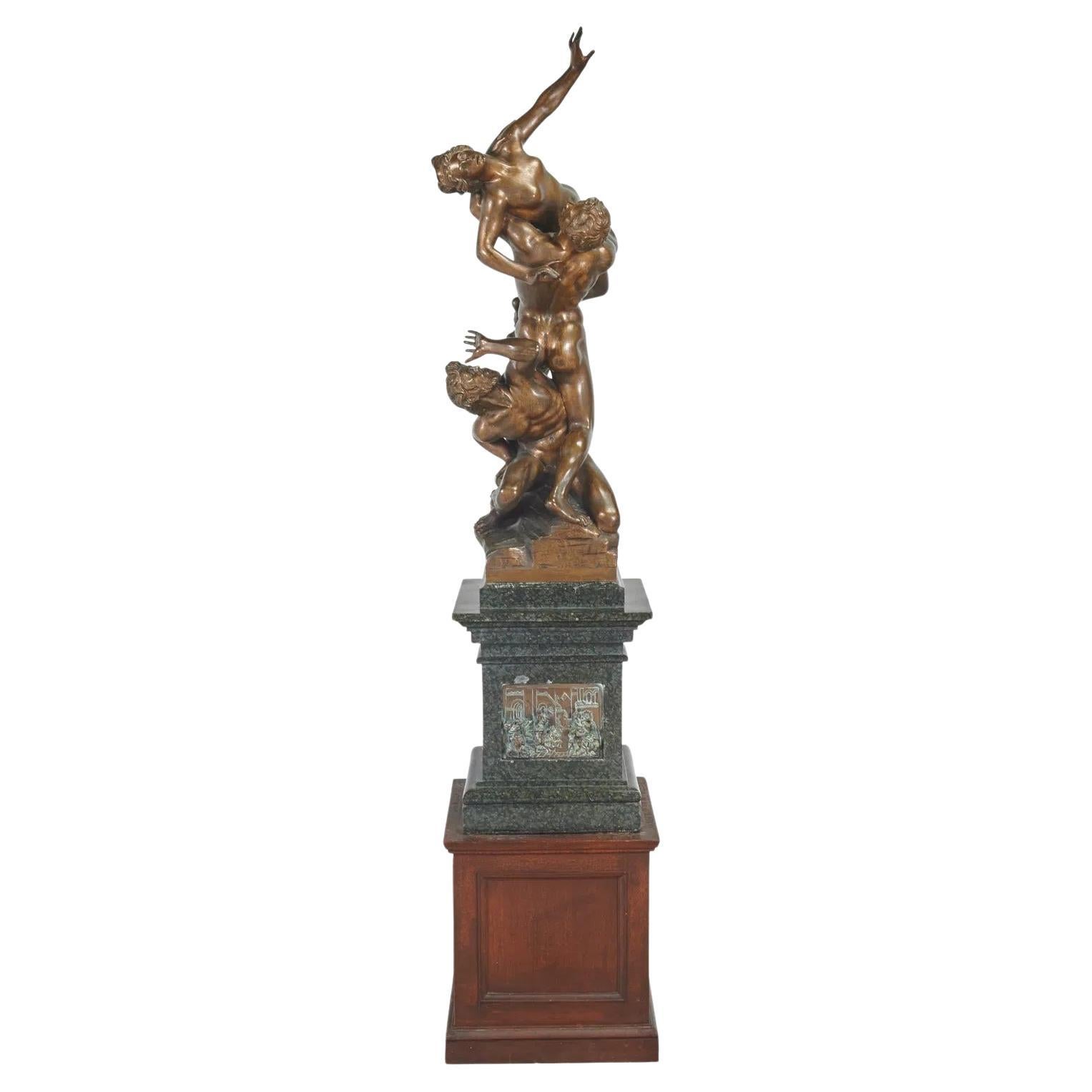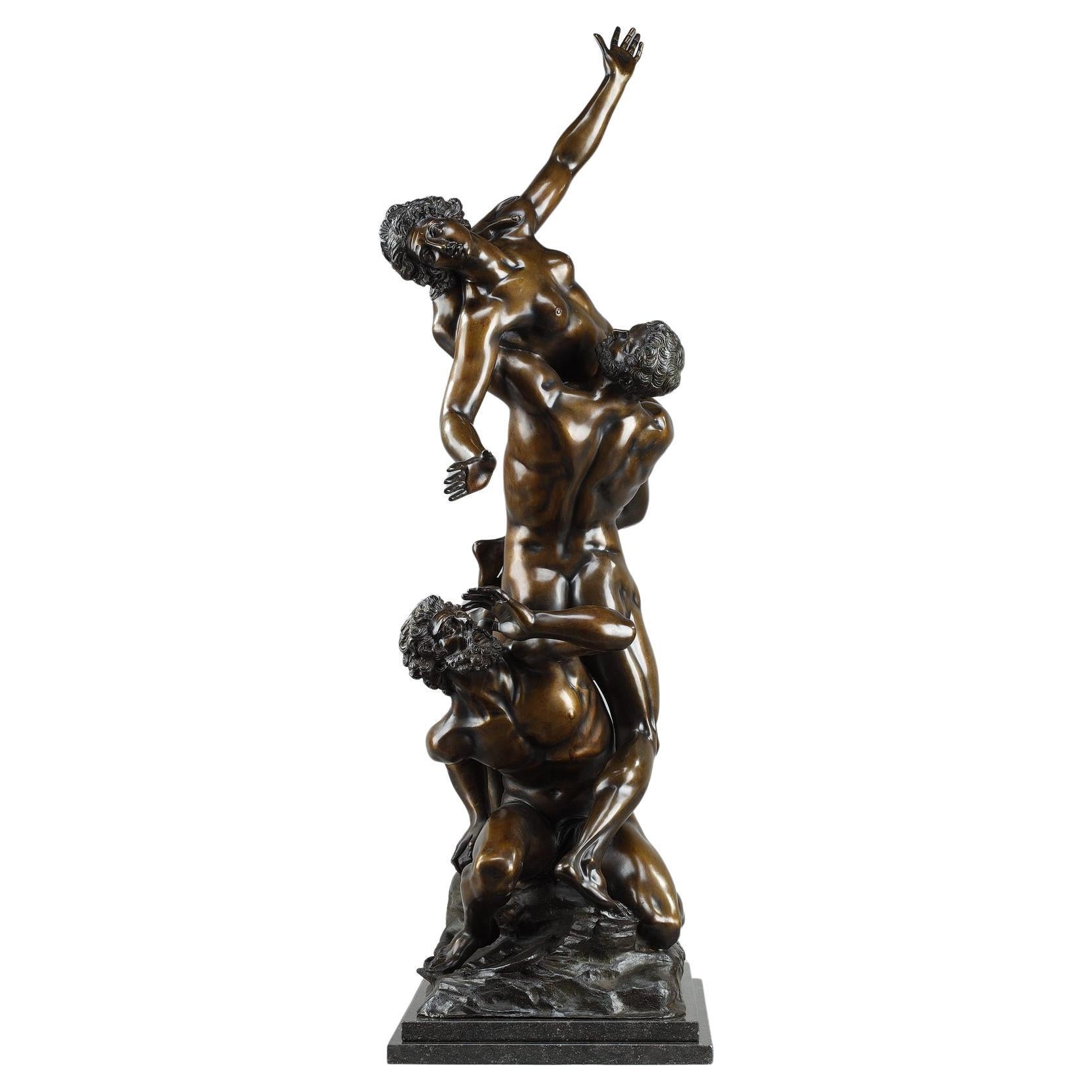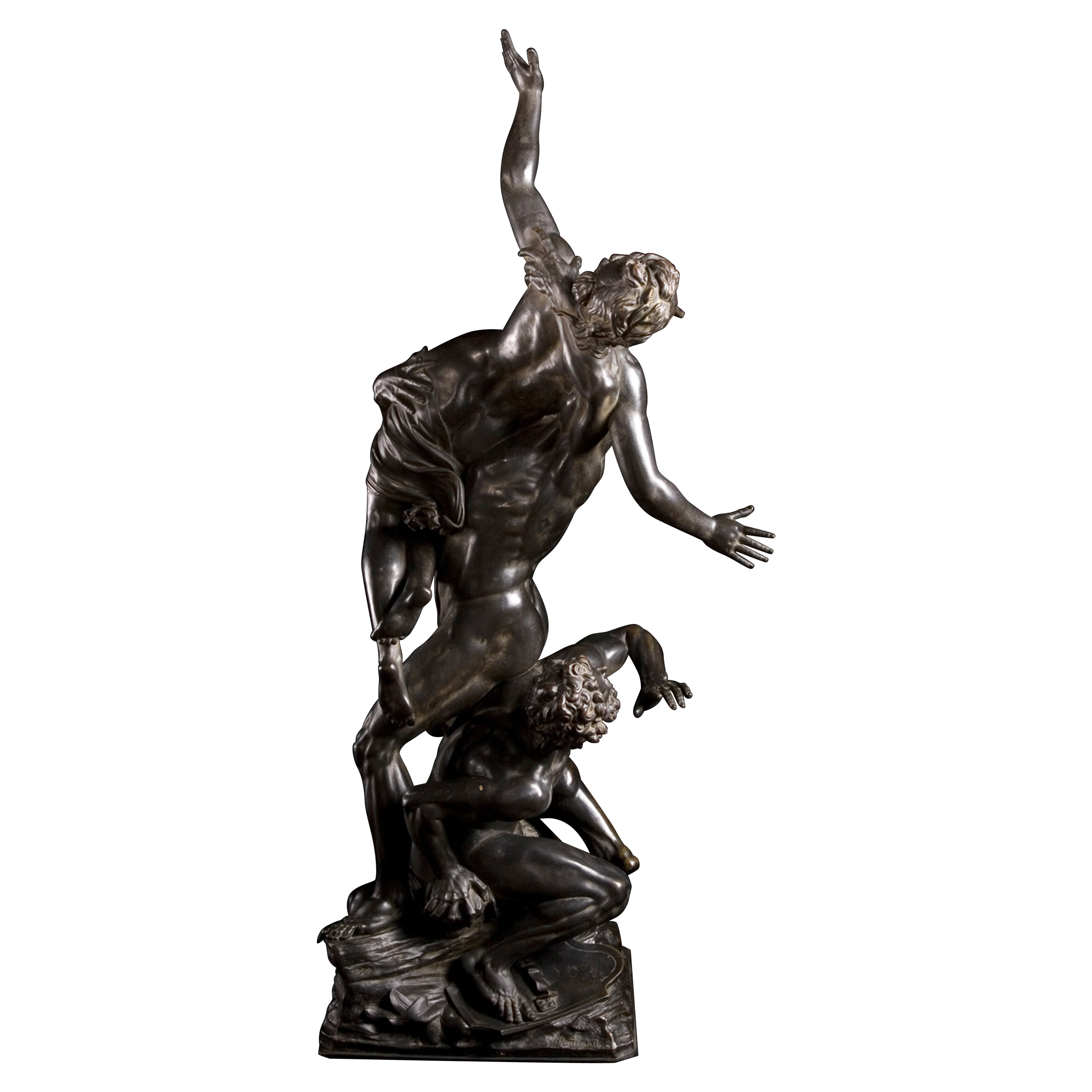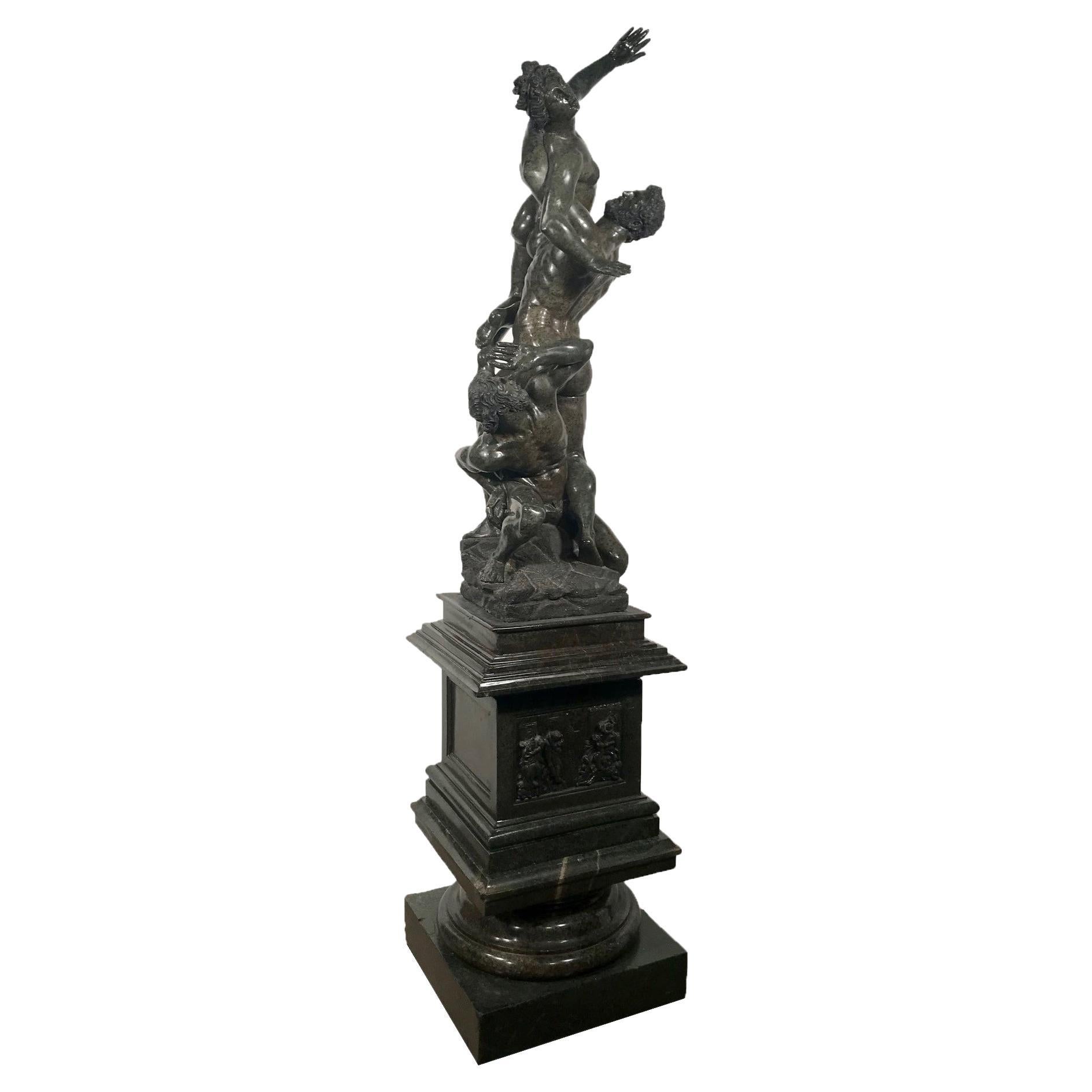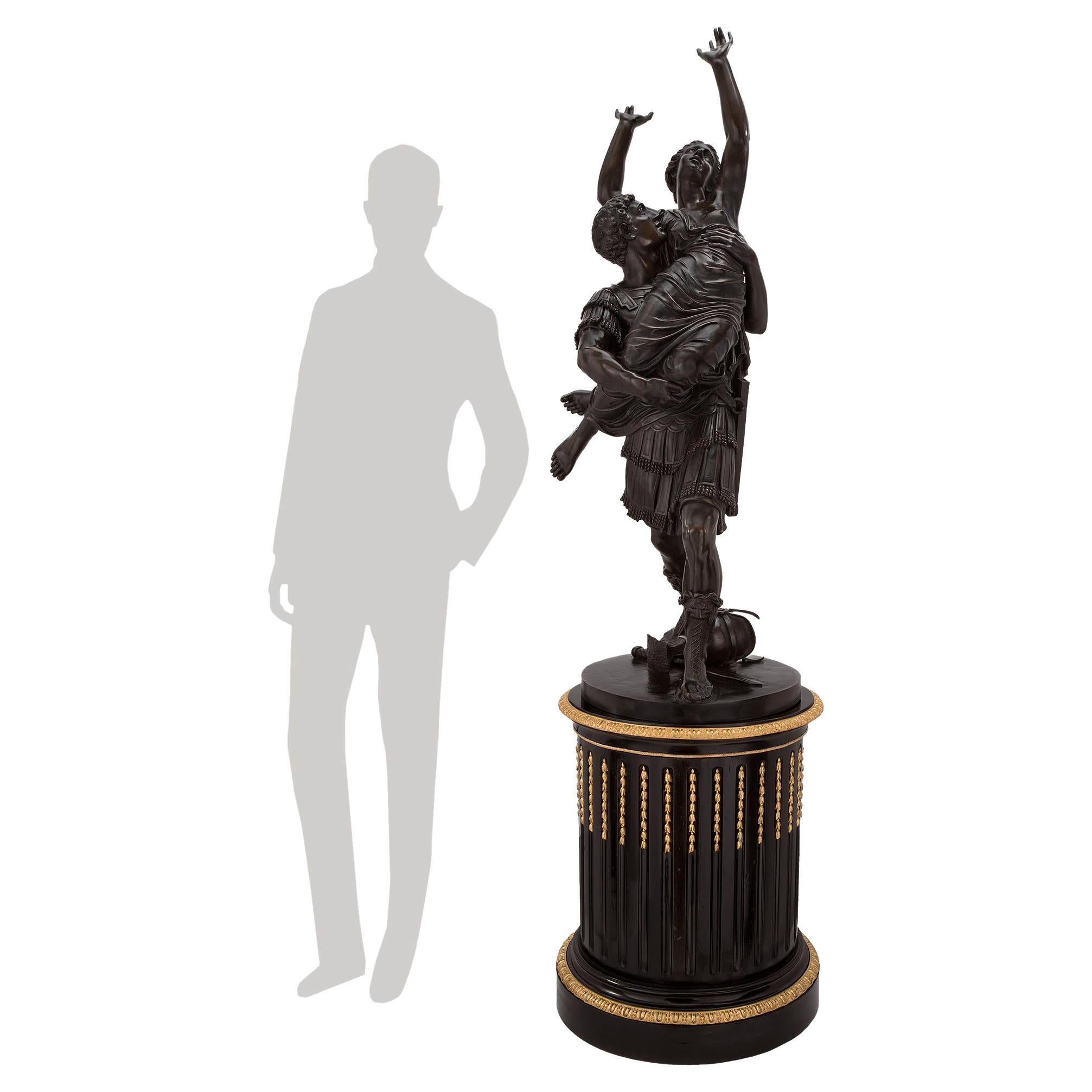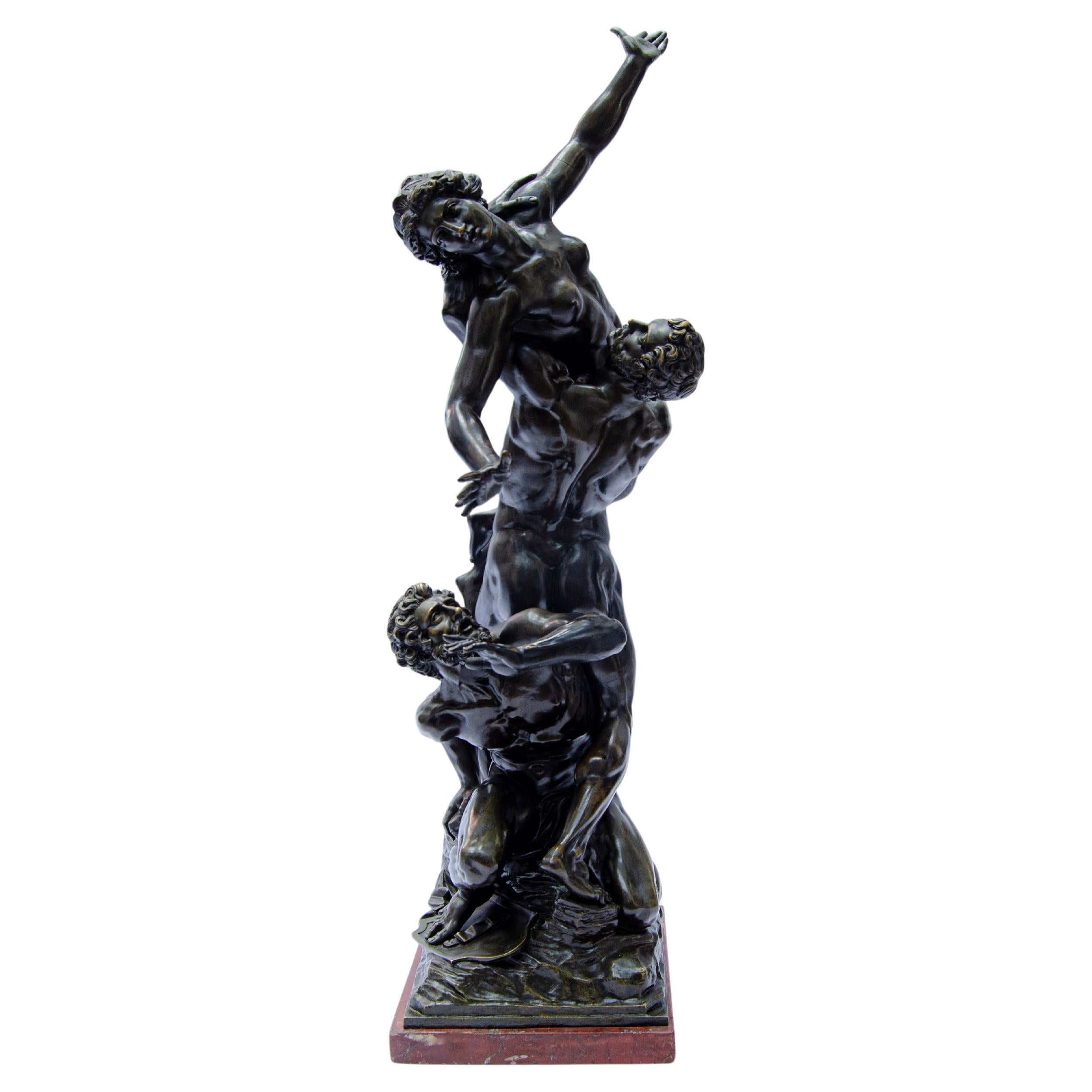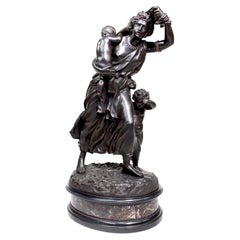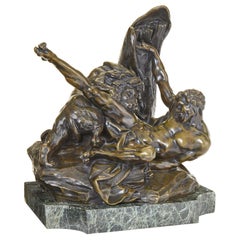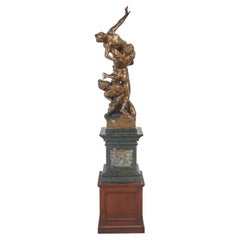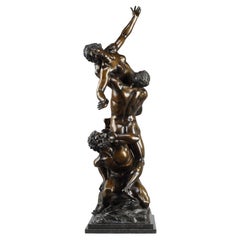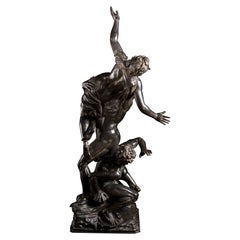Items Similar to French 19th Century Patinated Bronze Group "The Abduction of the Sabine Women"
Video Loading
Want more images or videos?
Request additional images or videos from the seller
1 of 12
French 19th Century Patinated Bronze Group "The Abduction of the Sabine Women"
$55,880per set
$125,000per set55% Off
£42,277.06per set
£94,571.09per set55% Off
€48,794.28per set
€109,149.69per set55% Off
CA$78,048.81per set
CA$174,590.21per set55% Off
A$86,775.37per set
A$194,110.97per set55% Off
CHF 45,421.67per set
CHF 101,605.39per set55% Off
MX$1,064,271.16per set
MX$2,380,706.78per set55% Off
NOK 578,332.76per set
NOK 1,293,693.54per set55% Off
SEK 546,014.66per set
SEK 1,221,400.02per set55% Off
DKK 364,118.91per set
DKK 814,510.80per set55% Off
Shipping
Retrieving quote...The 1stDibs Promise:
Authenticity Guarantee,
Money-Back Guarantee,
24-Hour Cancellation
About the Item
A very fine and Monumental French 19th century patinated bronze group Titled "The Abduction of the Sabine Women" after a model by Pierre Loison (French, 1816-1886), depicting a young scantily maiden being carried away on the arms of a Roman soldier, raised on circular ebonized wood and brass revolving pedestal stand. Signed at the base: P. Loison, circa: Paris, 1870-1880.
Overall height (Sculpture and Pedestal): 91 inches (231.2 cm).
Sculpture height: 54 3/4 inches (139.1 cm).
Sculpture width: 24 inches (61 cm).
Pedestal height: 36 inches (91.5 cm).
Pedestal width (Widest): 25 1/2 inches (64.8 cm).
Pierre Loison was a French sculptor of the 19th century born in the seaside town of Loir-et-Cher on July 5, 1816 and died in Cannes on February 3, 1886. In 1841, he joined the Pierre-Jean David d'Angers workshop where he became one of his favorite pupils. A year later he attended the School of Fine Arts in Paris. He exhibited for the first time at the Salon des artistes Français where in 1845 he was awarded third-class medal. In 1853 he was awarded First Place medal and at the Universal Exhibition of 1955 he received an honorable mention and another medal award in 1859.
On 12 July 1859 and by decree, he was made "Chevalier de la Légion d’Honneur".
Pierre Loison is buried at The Montparnasse Cemetery in Paris.
Works by Pierre Loison
"Femme assise": Terre cuite (1843) au musée Gustave-Moreau à Paris
"Jeune fille portant un vase": Statue en marbre blanc, (h. 1,25 m) datée de 1857 et présentée au Salon de 1859 ; la statue fut d’abord placée au Palais-Royal (appartements du prince Napoléon) ; elle est actuellement au musée des Beaux-arts de Dole ; une réplique de taille réduite est au Musée des arts décoratifs de Paris.
"La Halle aux grains de Mer": Chaque façade de ce bâtiment, classé à l’inventaire supplémentaire des monuments historiques, comporte un fronton triangulaire et celui de la façade ouest représentant « L’Agriculture distribuant des couronnes aux enfants de Beauce et de Sologne » a été sculpté gracieusement par P. Loison, natif de la commune.
"La Justice assise": Allégorie de la Justice au fronton du Palais de justice de Blois (1847).
"Buste d’Achille Fould": Au musée du Château de Blois 8;
"Nausicaa": Statue en plâtre présentée au Salon de 1874, au musée des Beaux-arts de Vendôme.
"Statue de J-B. Pigalle sur la façade de l’hôtel de ville de Paris
"Sculptures extérieures du Palais du Louvre": Pierre Loison est l’auteur de neuf statues qui décorent les façades du Louvre "Figure" (1878) au deuxième étage du Pavillon Marsan10; "La Navigation" (1868) sur la balustrade du premier étage du Pavillon des États11; "Pandore" (1861) sur l’aile Est12; « Vénus » (1865) Aile Marsan13; "l’Histoire et la Vérité" (1857)14; "La Poésie et la Philosophie" (1857)15 deux oculi du Pavillon Mollien, coté cour Napoléon ; "Concordet" (1857) sur la balustarde du premier étage de la Rotonde de Beauvais, coté cour Napoléon.
"Statue de Sappho sur le rocher de Leucade : datée de 1859, (h. 1,85 m) sur la façade nord de la cour carrée du Palais du Louvre à Paris ; le modèle en plâtre, offert par Mme Loison, est au musée des Beaux-arts de Blois.
"Vierge à l’enfant": Statue en marbre en l’église Saint-Pierre de Dampierre-en-Yvelines.
"Jeune romain enlevant une Sabine": Groupe présenté au Salon de 1863 qui a été reproduit en bronze par la fonderie d’art Raingo frères.
"Sépulture de la famille Hautoy : Au cimetière du Père-Lachaise, deux bas-reliefs en marbre représentant l’un "La vie de Famille," l’autre 'Le chantier," datés de 1880.
"Demoiselle d’honneur de la Cour de François Ier": Statue en pierre exposée au Salon des artistes vivants en 1870 ; acquise par l’État à ce Salon, elle a été déposée en 1891, devant la mairie d’Aubin.
"La Paix distribuant des palmes aux génies des Beaux-arts": Fronton du Château de Compiègne (1866).
"Daphnis et Naïs": Groupe en marbre (1869) au musée de Picardie à Amiens.
"Jean-Baptiste Pigalle": Statue en pierre (1881) sur la façade principale, au rez-de-chaussée de l’Hôtel de ville de Paris.
"Gisant de Ferdinand-Philippe d'Orléans: dans la chapelle royale de Dreux en collaboration avec Ary Scheffer.
"La Grace": Statue en marbre (1875) dans le grand foyer de l’opéra Garnier.
The Abduction of the Sabine Women
The Abduction of the Sabine Women is an episode in the legendary history of Rome, traditionally dated to 750 BC, in which the first generation of Roman men acquired wives for themselves from the neighboring Sabine families. Recounted by Livy and Plutarch (Parallel Lives II, 15 and 19), it provided a subject for Renaissance and post-Renaissance works of art that combined a suitably inspiring example of the hardihood and courage of ancient Romans with the opportunity to depict multiple figures, including heroically semi-nude figures, in intensely passionate struggle. Comparable themes from Classical Antiquity are the Battle of the Lapiths and Centaurs and the theme of Amazonomachy, the battle of Theseus with the Amazons.
The Abduction is supposed to have occurred in the early history of Rome, shortly after its founding by Romulus and his mostly male followers. Seeking wives in order to found families, the Romans negotiated unsuccessfully with the Sabines, who populated the area. Fearing the emergence of a rival society, the Sabines refused to allow their women to marry the Romans. Consequently, the Romans planned to abduct Sabine women, during a festival of Neptune Equester and proclaimed the festival among Rome's neighbours. According to Livy, many people from Rome's neighbours including folk from the Caeninenses, Crustumini, and Antemnates, and many of the Sabines attended. At the festival Romulus gave a Signal, at which the Romans grabbed the Sabine women and fought off the Sabine men. The indignant abductees were soon implored by Romulus to accept Roman husbands.
Livy says Romulus offered them free choice and promised civic and property rights to women. According to Livy, Romulus spoke to them each in person, declaring "that what was done was owing to the pride of their fathers, who had refused to grant the privilege of marriage to their neighbours; but notwithstanding, they should be joined in lawful wedlock, participate in all their possessions and civil privileges, and, than which nothing can be dearer to the human heart, in their common children." Responsibility of the men for meeting the needs of the children thus conceived was not included.
War with the Sabines and other tribes
Outraged at the occurrence, the King of the Caeninenses entered upon Roman territory with his army. Romulus and the Romans met the Caeninenses in battle, killed their king, and routed their army. Romulus later attacked Caenina and took it upon the first assault. Returning to Rome, he dedicated a temple to Jupiter Feretrius (according to Livy, the first temple dedicated in Rome) and offered the spoils of the enemy king as spolia opima. According to the Fasti Triumphales, Romulus celebrated a triumph over the Caeninenses on 1 March 752 BC.
At the same time, the army of the Antemnates invaded Roman territory. The Romans retaliated, and the Antemnates were defeated in battle and their town captured. According to the Fasti Triumphales, Romulus celebrated a second triumph in 752 BC over the Antemnates.
The Crustumini also started a war, but they too were defeated and their town captured.
Roman colonists subsequently were sent to Antemnae and Crustumerium by Romulus, and many citizens of those towns also migrated to Rome (particularly the families of the captured women).
The Sabines themselves finally declared war, led into battle by their king, Titus Tatius. Tatius almost succeeded in capturing Rome, thanks to the treason of Tarpeia, daughter of Spurius Tarpeius, governor of the citadel on the Capitoline Hill. She opened the city gates for the Sabines in return for "what they bore on their arms", thinking she would receive their golden bracelets. Instead, the Sabines crushed her to death with their shields, and her body was thrown from a rock known ever since by her name, the Tarpeian Rock.
The Romans attacked the Sabines, who now held the citadel. The Roman advance was led by Hostus Hostilius, the Sabine defence by Mettus Curtius. Hostus fell in battle, and the Roman line gave way, They retreated to the gate of the Palatium. Romulus rallied his men by promising to build a temple to Jupiter Stator on the site. He then led them back into battle. Mettus Curtius was unhorsed and fled on foot, and the Romans appeared to be winning.
At this point, however, the Sabine women intervened:
[They], from the outrage on whom the war originated, with hair dishevelled and garments rent, the timidity of their sex being overcome by such dreadful scenes, had the courage to throw themselves amid the flying weapons, and making a rush across, to part the incensed armies, and assuage their fury; imploring their fathers on the one side, their husbands on the other, "that as fathers-in-law and sons-in-law they would not contaminate each other with impious blood, nor stain their offspring with parricide, the one their grandchildren, the other their children. If you are dissatisfied with the affinity between you, if with our marriages, turn your resentment against us; we are the cause of war, we of wounds and of bloodshed to our husbands and parents. It were better that we perish than live widowed or fatherless without one or other of you."
The battle came to an end, and the Sabines agreed to unite in one nation with the Romans. Titus Tatius jointly ruled with Romulus until Tatius's death five years later.
The new Sabine residents of Rome settled on the Capitoline Hill, which they had captured in the battle.
Artistic representations:
The Rape of the Sabine Women by Johann Heinrich Schönfeld
The subject was popular during the Renaissance as symbolising the importance of marriage for the continuity of families and cultures. It was also an example of a battle subject in which the artist could demonstrate his skill in depicting female as well as male figures in extreme poses, with the added advantage of a sexual theme. It was depicted regularly on 15th-century Italian cassoni and later in larger paintings. A comparable opportunity from the New Testament was afforded by the theme of the Massacre of the Innocents.
Giambologna
The sculpture by Giambologna (1579–1583) that was reinterpreted as expressing this theme depicts three figures (a man lifting a woman into the air while a second man crouches) and was carved from a single block of marble. This sculpture is considered Giambologna's masterpiece. Originally intended as nothing more than a demonstration of the artist's ability to create a complex sculptural group, its subject matter, the legendary rape of the Sabines, had to be invented after Francesco I de' Medici, Grand Duke of Tuscany, decreed that it be put on public display in the Loggia dei Lanzi in Piazza della Signoria, Florence. True to mannerist densely packed, intertwined figural compositions and ambitious overinclusive efforts, the statue renders a dynamic panoply of emotions, in poses that offer multiple viewpoints. When contrasted with the serene single-viewpoint pose of the nearby Michelangelo's David, finished nearly 80 years before, this statue is infused with the dynamics that lead towards Baroque, but the tight, uncomfortable, verticality— self-imposed by the author's virtuosic restriction to a composition that could be carved from a single block of marble— lacks the diagonal thrusts that Bernini would achieve forty years later with his Rape of Proserpina and Apollo and Daphne, both at the Galleria Borghese, Rome.
The proposed site for the sculpture, opposite Benvenuto Cellini's statue of Perseus, prompted suggestions that the group should illustrate a theme related to the former work, such as the rape of Andromeda by Phineus. The respective rapes of Proserpina and Helen were also mooted as possible themes. It was eventually decided that the sculpture was to be identified as one of the Sabine virgins.
The work is signed OPVS IOANNIS BOLONII FLANDRI MDLXXXII ("The work of Johannes of Boulogne of Flanders, 1582"). An early preparatory bronze featuring only two figures is in the Museo Nazionale di Capodimonte in Naples. Giambologna then revised the scheme, this time with a third figure, in two wax models now in the Victoria and Albert Museum, London. The artist's full-scale gesso for the finished sculpture, executed in 1582, is on display at the Accademia Gallery in Florence.
Bronze reductions of the sculpture, produced in Giambologna's own studio and imitated by others, were a staple of connoisseurs' collections into the 19th century.
Nicolas Poussin
Nicolas Poussin produced two major versions of this subject, which enabled him to display to the full his unsurpassed antiquarian knowledge, together with his mastery of complicated relations of figures in dramatic encounter. One, now at the Metropolitan Museum of Art, was executed in Rome, 1634–35. It depicts Romulus at the left giving the Signal for the abduction.
The second version, of 1636–37, now at the Louvre Museum, shows that, though some of the principal figures are similar, he had not exhausted the subject. The architectural setting is more developed.
Peter Paul Rubens
Peter Paul Rubens painted a version of the subject about 1635–40. It is at the National Gallery, London.
Jacques-Louis David
Jacques-Louis David painted the other end of the story, when the women intervene to reconcile the warring parties. The Sabine Women Enforcing Peace by Running Between the Combatants (also known as The Intervention of the Sabine Women ) was completed in 1799. It is in the Louvre Museum.
David had worked on it from 1796, when France was at war with other European nations after a period of civil conflict culminating in the Reign of Terror and the Thermidorian Reaction, during which David himself had been imprisoned as a supporter of Robespierre. After David’s estranged wife visited him in jail, he conceived the IDEA of telling the story, to honor his wife, with the theme being love prevailing over conflict. The painting was also seen as a plea for the people to reunite after the bloodshed of the revolution.
The painting depicts Romulus's wife Hersilia — the daughter of Titus Tatius, leader of the Sabines — rushing between her husband and her father and placing her babies between them. A vigorous Romulus prepares to strike a half-retreating Tatius with his spear, but hesitates. Other soldiers are already sheathing their swords.
The rocky outcrop in the background is the Tarpeian Rock.
John Leech
The English 19th century satirical painter John Leech included in his Comic History of Rome a depiction of the Rape of the Sabine Women, where the women are portrayed, with a deliberate anachronism, in Victorian costume and being carried off from the "Corona et Ancora" ("Crown and Anchor", a common English pub sign in seafaring towns).
Pablo Picasso
Pablo Picasso visited this theme in his several versions of the Rape of the Sabine Women (1962–63), one of which is in the Museum of Fine Arts, Boston. These are based on David's version. These conflate the beginning and end of the story, depicting the brutish Romulus and Tatius ignoring and trampling on the exposed figure of Hersilia and her child.
Literature and performing arts
Stephen Vincent Benét wrote a short story called "The Sobbin' Women" that parodied the legend. Later adapted into the musical Seven Brides for Seven Brothers, it tells the story of seven gauche but sincere backwoodsmen, one of whom gets married, encouraging the others to seek partners. After a social where they meet girls they are attracted to, they are denied the chance to pursue their courtship by the latter's menfolk. Following the Roman example, they abduct the girls. As in the original tale, the women are at first indignant but are eventually won over.
The story was parodied by Lady Carlotta, the mischief-making character in Saki's short story The Schartz-Metterklume Method.
The midrash Sefer haYashar (first attested AD 1624) portrays the story as part of a war between the Sabines, descended from Tubal, and the Roman Kittim (Jasher 17:1-15). A more detailed version of this narrative is found in the earlier mediaeval rabbinic work Yosippon.
In 1954, the movie "Seven Brides for Seven Brothers" used the Sabines as the basis for the unmarried 6 brothers to get wives. The song used was called "Sobbin Women" instead of Sabine Women".
In 1962, a Spanish "sword and sandal" film based on the story was made, directed by Alberto Gout. Titled El Rapto de las Sabinas, the film was released in the USA under the titles The Rape of the Sabine Women and The Shame of the Sabine Women.
The latest adaptation is a video film, The Rape of the Sabine Women without dialogue, which was produced in 2005 by Eve Sussman and the Rufus Corporation.[9]
Tom Stoppard's play "Rosencrantz and Guildenstern Are Dead" features an all-male players offering to put on a performance of The Rape of the Sabine Women, to the disgust of the title characters.
Cultural Context
Main article: Raptio (See also: Bride kidnapping)
Scholars have cited parallels between The Rape of the Sabine Women, the Æsir–Vanir War in Norse mythology, and the Mahabharata from Hindu mythology, providing support for a Proto-Indo-European "war of the functions." Regarding these parallels, J. P. Mallory states:
Basically, the parallels concern the presence of first-(magico-juridical) and second-(warrior) function representatives on the victorious side of a war that ultimately subdues and incorporates third function characters, for example, the Sabine women or the Norse Vanir. Indeed, the Iliad itself has also been examined in a similar light. The ultimate structure of the myth, then, is that the three estates of Proto-Indo-European society were fused only after a war between the first two against the third.
Adaptations:
Il ratto delle sabine (1961, film)
Bibliography:
Pope-Hennessy, John, Italian High Renaissance & Baroque Sculpture, London: Phaidon, 1996.
Livy, Ab urbe condita, 1.9-13.
Mallory, J. P (2005). In Search of the Indo-Europeans. Thames & Hudson. ISBN 0-500-27616-1
Walter Friedlaender, Nicolas Poussin: A New Approach (New York: Abrams), 1964
Notes:
Benjamin Vincent, Haydn's Dictionary of Dates (New York: GP Putnam & Sons, 1874), 572.
Livy, Ab urbe condita 1.9.
Livy, Ab urbe condita, 1.10
Livy, Ab urbe condita 1.13
Livy, Ab urbe condita, 1:33
Liam E. Semler, The English Mannerist Poets and the Visual Arts 1998, ISBN
Literature:
Reference Bibliographique: S. Lami, Dictionnaire des Sculpteurs de L'école Française Au XIXe Siècle, t. III, Paris, 1919 (ré. éd. 1970), p. 356-361.
- Attributed to:Pierre Loison 1 (Sculptor)
- Dimensions:Height: 54.75 in (139.07 cm)Width: 22 in (55.88 cm)Depth: 24 in (60.96 cm)
- Sold As:Set of 2
- Style:Mannerist (In the Style Of)
- Materials and Techniques:
- Place of Origin:
- Period:
- Date of Manufacture:circa 1870-1880
- Condition:Wear consistent with age and use. Minor fading. Overall condition of this sculpture is good and quite impressive. It has minor wear and rubbing consistent with age and use. The ebonized revolving pedestal has been recently fully restored and is in excellent condition.
- Seller Location:Los Angeles, CA
- Reference Number:Seller: Ref.: A20271stDibs: LU179624002403
About the Seller
5.0
Vetted Professional Seller
Every seller passes strict standards for authenticity and reliability
Established in 1982
1stDibs seller since 2016
133 sales on 1stDibs
Typical response time: 1 hour
- ShippingRetrieving quote...Shipping from: Los Angeles, CA
- Return Policy
Authenticity Guarantee
In the unlikely event there’s an issue with an item’s authenticity, contact us within 1 year for a full refund. DetailsMoney-Back Guarantee
If your item is not as described, is damaged in transit, or does not arrive, contact us within 7 days for a full refund. Details24-Hour Cancellation
You have a 24-hour grace period in which to reconsider your purchase, with no questions asked.Vetted Professional Sellers
Our world-class sellers must adhere to strict standards for service and quality, maintaining the integrity of our listings.Price-Match Guarantee
If you find that a seller listed the same item for a lower price elsewhere, we’ll match it.Trusted Global Delivery
Our best-in-class carrier network provides specialized shipping options worldwide, including custom delivery.More From This Seller
View AllAn Italian Cast 19th Century Bronze Group Mother & Children Titled "La Tempête"
By Mathurin Moreau
Located in Los Angeles, CA
A Fine Italian Cast 19th Century Bronze Group Titled "La Tempête" (The Tempest) Probably after Mathurin Moreau (French, 1822–1912), Cast by The Alessandro Nelli Foundry in Rome. The ...
Category
Antique Early 1900s Italian Classical Roman Figurative Sculptures
Materials
Marble, Bronze
$15,160 Sale Price
20% Off
Italian 19th Century Bronze Sculpture Group of a Two-Horse Roman Chariot & Rider
Located in Los Angeles, CA
A fine and large Italian 19th century Greco Roman style brown patinated bronze sculpture group of a two-horse Roman Chariot and rider in a dark patina, raised on a fitted Verde d'alp...
Category
Antique 19th Century Italian Greco Roman Figurative Sculptures
Materials
Marble, Bronze
$12,950 Sale Price
22% Off
French 19th/20th Century Bronze of a Fairy “Lutin des Bois”, After Luca Madrassi
By Luca Madrassi
Located in Los Angeles, CA
A Fine French 19th/20th Century Patinated Bronze Figure titled “Lutin des Bois” (Woodland Fairy or Elf) after Luca Madrassi (Italian, 1869-1914). The beautifully executed slender fig...
Category
Antique Early 1900s French Belle Époque Figurative Sculptures
Materials
Bronze
$12,450 Sale Price
32% Off
Fine French 19th Century Bronze Figure of "Milo of Croton & Lion" After Falconet
By Étienne Maurice Falconet
Located in Los Angeles, CA
A very fine French 19th century Patinated bronze Figure of "Milo of Croton and the Lion" after the marble sculpture of Milon de Crotone by renown French...
Category
Antique 19th Century French Baroque Figurative Sculptures
Materials
Marble, Bronze
$12,450 Sale Price
32% Off
Over-Lifesize Patinated Bronze Greco Roman Standing Half-Figure of Andromeda
Located in Los Angeles, CA
A fine over-lifesize patinated bronze Greco roman revival style standing half-figure of Andromeda, probably French, probably late 19th century or early 20th century. The heavily fine...
Category
Antique Late 19th Century French Greco Roman Figurative Sculptures
Materials
Bronze
A French 19th Century Bronze Sculpture Titled "La Sécurité" Eugène Delaplanche
By Eugène Delaplanche
Located in Los Angeles, CA
A very fine French 19th century brown and parcel-gilt patinated bronze sculpture titled "La Sécurité" (The Security - Protection) after a model by Eugène Delaplanche (French, 1836–1891). Depicting a sitting young Maiden in a gilt-decorated armored suit and helmet, a lion skin on her back, holding a resting child on her arm. Raised on Rouge-Royal marble plinth inscribed "La Sécurité - Par E. Delaplanche - Salon des Beaux-Arts de Paris". Signed: E. Delaplanche and stamped with the importer's seal - Alberto Vignes y Ca - Buenos Aires, circa 1890.
Measures: Height: 28 3/4 inches (60.3 cm).
Width: 16 inches (40.7 cm).
Depth: 14 inches (35.6 cm).
Eugène Delaplanche (February 28, 1836 – January 10, 1891) was a French sculptor, born at Belleville (Seine).
He was a pupil of Duret, gained the Prix de Rome in 1864 (spending 1864-67 at the Villa Medici in Rome) and the medal of honor in 1878. His "Messenger of Love" (1874), "Aurora" (1878), and the "Virgin of the Lillies" (1884), are in the Luxembourg. Other works by him are "Music - La Musique" (1878, Paris Opera House), called his masterpiece; "Eve After the Fall" (1869); "Maternal Instruction" (1875, Square of Sainte-Clothilde, Paris). He is also noted for his decorations in relief on vases of Haviland faience. His best work is naturalistic, but at the same time dignified and simple in line and shows sound mastery of technique. He is represented by 15 works in the Glyptothek, Copenhagen and in many other French museums and in churches.
This sculpture of La Sécurité is after his 1884 sculptures...
Category
Antique Late 19th Century French Belle Époque Figurative Sculptures
Materials
Marble, Bronze
$18,450 Sale Price
47% Off
You May Also Like
Bronze Statue of Abduction of the Sabine Woman After Giambologna
By Giambologna
Located in New York, NY
A fine casting of the Abduction of the Sabine Woman after Giambologna (1529-1608), mounted on marble pedestal with bronze relief of the same subject matter, placed on wooden pedestal...
Category
Antique Late 19th Century Neoclassical Figurative Sculptures
Materials
Bronze
Very Large Bronze "Abduction of a Sabine Woman" After Giambologna, 19th Cent
By Giambologna, Ferdinando de Luca
Located in Paris, FR
Very large bronze sculpture with brown patina, based on the group "The Rape of the Sabine Women" by John of Bologna (Giambologna). This pivoting composition shows three figures in motion: a man on the ground defeated with his shield turned upside down, a second one arched clutching a woman launched towards the sky trying to escape, all on a naturalistic base. The Sabine man, the Roman and the Sabine woman are all depicted naked. This staging plays on serpentine lines known as "figura serpentinata" and diagonals giving a beautiful variety of volumes and a multiplicity of angles of view. The bronze is signed F. De Luca...
Category
Antique 1880s French Baroque Figurative Sculptures
Materials
Bronze
French 19th Century Paillard Bronze, ‘Abduction of A Sabine Woman' Signed
Located in New Orleans, LA
Gorgeous French 19th century bronze study of the Flemish sculptor and architect Giambologna's "Abduction of A Sabine Woman" signed V. Paillard. Victor Paillard, a 19th century bronzi...
Category
Antique 19th Century French Figurative Sculptures
Materials
Bronze
$45,000 Sale Price
25% Off
After Giambologna: The Abduction of a Sabine Woman
By Giambologna
Located in Montreal, QC
This fine 19th century copy of the famous group is in a sumptuous Serpentine marble. The Sabine man crouches in submissive pose, whilst the Roman carries off the writhing woman. It is well-presented on the original matching plinth and pedestal . This perhaps forms part of someone's Grand Tour along with mosaics and bronzes after the antique...
Category
Antique 1850s Italian Renaissance Figurative Sculptures
Materials
Marble, Serpentine
French 19th Century Louis XVI Style Bronze Statue of L’Enlevement Des Sabines
Located in West Palm Beach, FL
A sensational and large scale French 19th century Louis XVI st. bronze statue of L'Enlevement des Sabines on its original Base. The high quality bronze is raised by a circular fluted...
Category
Antique 19th Century French Louis XVI Figurative Sculptures
Materials
Bronze
"The Rape of the Sabine Woman" by Jean de Bologna
By Jean de Bologne
Located in Ciudad Autónoma Buenos Aires, C
Sculpture called "The Rape of the Sabine" made by Jean de Bologna (1529 -1608), made of bronze and patinated in brown. This is a replica of the author's most important work. The work...
Category
Antique Early 17th Century French Baroque Figurative Sculptures
Materials
Bronze
More Ways To Browse
English Pub
Bronze Anchor
Antique Black Wood Stain
Antique Palais Royal
Spanish Furniture 15th Century
English Pub Sign
Wood Hindu
Pierre Deux
Les Pierre Antiques
Weapons Swords
Baroque Italian Pedestal
Italian Tuscany Vases
Folk Art Soldier
Gesso Relief
Napoleon Wood Painting
Victorian Sword
Sex Original
1970s Studio 54
